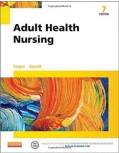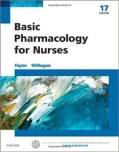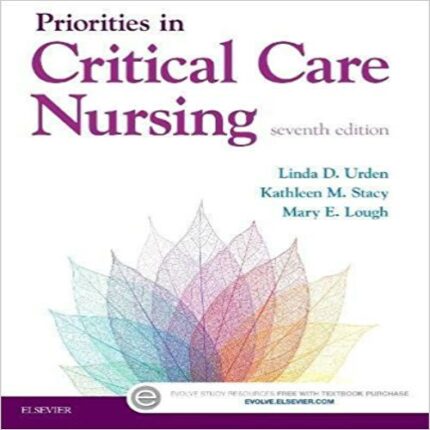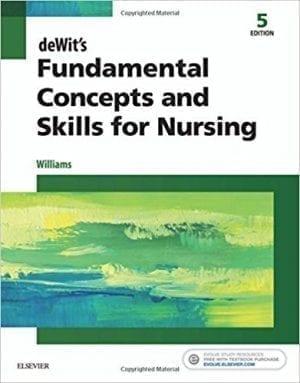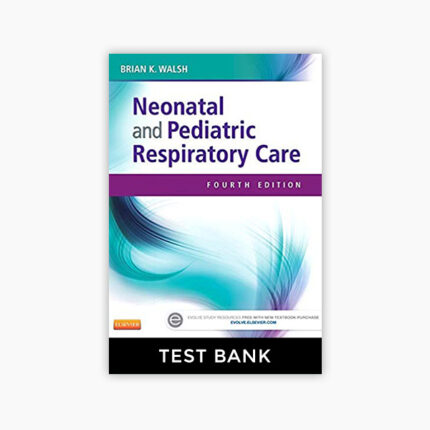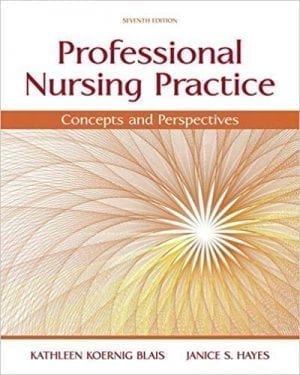Chapter 1: Introduction to Anatomy and Physiology
MULTIPLE CHOICE
- The anatomic term ____ means toward the midline.
| a. | anterior |
| b. | posterior |
| c. | medial |
| d. | cranial |
ANS: C
The term medial indicates an anatomic direction toward the midline.
DIF: Cognitive Level: Knowledge REF: Page 1 OBJ: 2
TOP: Anatomic terminology KEY: Nursing Process Step: Assessment
MSC: NCLEX: Physiological Integrity
- What are the smallest living components in our body?
| a. | Cells |
| b. | Organs |
| c. | Electrons |
| d. | Osmosis |
ANS: A
Cells are considered to be the smallest living units of structure and function in our body.
DIF: Cognitive Level: Knowledge REF: Page 4 OBJ: 6
TOP: Structural levels of organization KEY: Nursing Process Step: N/A
MSC: NCLEX: Physiological Integrity
- What is the largest organelle, responsible for cell reproduction and control of other organelles?
| a. | Nucleus |
| b. | Ribosome |
| c. | Mitochondrion |
| d. | Golgi apparatus |
ANS: A
The nucleus is the largest organelle within the cell.
DIF: Cognitive Level: Knowledge REF: Page 5 OBJ: 8
TOP: Parts of the cell KEY: Nursing Process Step: Assessment
MSC: NCLEX: Physiological Integrity
- When the patient complains of pain in the bladder, the patient will indicate discomfort in which body cavity?
| a. | Pelvic |
| b. | Mediastinum |
| c. | Dorsal |
| d. | Abdominal |
ANS: A
A subdivision called the pelvic cavity contains the lower portion of the large intestine (lower sigmoid colon, rectum), urinary bladder, and internal structures of the reproductive system.
DIF: Cognitive Level: Comprehension REF: Page 3, Figure 1-4
OBJ: 5 TOP: Body cavity KEY: Nursing Process Step: Assessment
MSC: NCLEX: Physiological Integrity
- The four phases of cell division all occur in:
| a. | diffusion. |
| b. | mitosis. |
| c. | osmosis. |
| d. | filtration. |
ANS: B
During mitosis, the cell goes through four phases: prophase, metaphase, anaphase, and telophase.
DIF: Cognitive Level: Knowledge REF: Page 7 OBJ: 9
TOP: Cell division KEY: Nursing Process Step: N/A
MSC: NCLEX: Physiological Integrity
- Telophase is which phase of cell reproduction during mitosis?
| a. | First phase |
| b. | Latent phase |
| c. | Final phase |
| d. | Spindle phase |
ANS: C
During mitosis, the cell goes through four phases: prophase, metaphase, anaphase, and telophase.
DIF: Cognitive Level: Knowledge REF: Page 7 OBJ: 9
TOP: Cell division KEY: Nursing Process Step: N/A
MSC: NCLEX: Physiological Integrity
- The nurse is aware that which muscle group is both striated and involuntary?
| a. | Skeletal |
| b. | Glial |
| c. | Cardiac |
| d. | Visceral |
ANS: C
The cardiac muscle is both striated and involuntary.
DIF: Cognitive Level: Knowledge REF: Page 9-10, Figure 1-12
OBJ: 11 TOP: Tissues KEY: Nursing Process Step: Planning
MSC: NCLEX: Physiological Integrity
- What is a group of several different kinds of tissues arranged so that together they can perform a more complex function than any tissue alone?
| a. | Organ |
| b. | System |
| c. | Cell |
| d. | Endoplasmic reticulum |
ANS: A
When several kinds of tissues are united to perform a more complex function than any tissue alone, they are called organs.
DIF: Cognitive Level: Knowledge REF: Page 11 OBJ: 7
TOP: Organs KEY: Nursing Process Step: N/A
MSC: NCLEX: Physiological Integrity
- What traits describe visceral muscles?
| a. | Smooth and voluntary |
| b. | Smooth and involuntary |
| c. | Striated and voluntary |
| d. | Striated and involuntary |
ANS: B
Visceral (smooth) muscles will not function at will; thus, they act involuntarily.
DIF: Cognitive Level: Knowledge REF: Page 9, Figure 1-12
OBJ: 7 TOP: Tissues KEY: Nursing Process Step: Assessment
MSC: NCLEX: Physiological Integrity
- How are the thoracic and abdominal cavities separated?
| a. | By the pleura |
| b. | By the diaphragm |
| c. | By the sagittal plane |
| d. | By the peritoneum |
ANS: B
The diaphragm (a muscle directly beneath the lungs) separates the ventral cavity into the thoracic (chest) and abdominal cavities.
DIF: Cognitive Level: Knowledge REF: Page 10, Figure 1-3
OBJ: 3 TOP: Ventral cavity
KEY: Nursing Process Step: Assessment MSC: NCLEX: Physiological Integrity
- What is the broad section of biology dealing with the description of human structure?
| a. | Hematology |
| b. | Anatomy |
| c. | Kinesiology |
| d. | Physiology |
ANS: B
Anatomy is the study, classification, and description of the structure and organs of the body.
DIF: Cognitive Level: Knowledge REF: Page 1 OBJ: 1
TOP: Terminology KEY: Nursing Process Step: N/A
MSC: NCLEX: Physiological Integrity
- ____ explains the processes and functions of many structures of the body and how they interact with one another.
| a. | Anatomy |
| b. | Mitosis |
| c. | Filtration |
| d. | Physiology |
ANS: D
Physiology explains the processes and functions of the various structures and how they interrelate with one another.
DIF: Cognitive Level: Knowledge REF: Page 1 OBJ: 1
TOP: Terminology KEY: Nursing Process Step: N/A
MSC: NCLEX: Physiological Integrity
- The anatomic structure that is not in the thoracic cavity is/are the _____.
| a. | Heart |
| b. | Lungs |
| c. | Blood vessels |
| d. | Transverse colon |
ANS: D
The transverse colon is located in the abdominal cavity.
DIF: Cognitive Level: Comprehension REF: Page 2, Figure 1-3
OBJ: 5 TOP: Thoracic cavity
KEY: Nursing Process Step: Assessment MSC: NCLEX: Physiological Integrity
- When several organs and parts are grouped together for certain functions, they form:
| a. | tissues. |
| b. | systems. |
| c. | cells. |
| d. | membranes. |
ANS: B
A system is an organization of varying numbers and kinds of organs arranged so that together they can perform complex functions for the body.
DIF: Cognitive Level: Knowledge REF: Page 4 OBJ: 7
TOP: Systems KEY: Nursing Process Step: Assessment
MSC: NCLEX: Physiological Integrity
- What are the distinct surface proteins of the plasma membrane essential in determining?
| a. | Tissue typing |
| b. | Blood count |
| c. | Effectiveness of a drug |
| d. | Sexual maturity |
ANS: A
The plasma membrane has distinct surface proteins as coming from one individual. This is the basis for the procedure of tissue typing to determine compatibility before an organ transplant.
DIF: Cognitive Level: Comprehension REF: Page 5 OBJ: 12
TOP: Cells KEY: Nursing Process Step: Assessment
MSC: NCLEX: Physiological Integrity
- In anatomic terminology, posterior means toward the:
| a. | tail. |
| b. | head. |
| c. | back. |
| d. | trunk. |
ANS: C
The posterior is toward the back.
DIF: Cognitive Level: Knowledge REF: Page 1 OBJ: 2
TOP: Anatomic terminology KEY: Nursing Process Step: Assessment
MSC: NCLEX: Physiological Integrity
- What does the transverse body plane divide?
| a. | The front and back (coronal) of the body |
| b. | The body lengthwise (two equal halves) |
| c. | The superior and inferior portions of the body |
| d. | The body into axial and appendicular |
ANS: C
The transverse plane cuts the body horizontally into the sagittal and the frontal planes, dividing the body into caudal and cranial portions.
DIF: Cognitive Level: Knowledge REF: Page 2, Figure 1-2
OBJ: 3 TOP: Body planes KEY: Nursing Process Step: Assessment
MSC: NCLEX: Physiological Integrity
- Caudal is defined as toward the ____.
| a. | head |
| b. | feet |
| c. | tail |
| d. | chest |
ANS: C
Caudal is a directional word that indicates toward the “tail,” the distal portion of the spine.
DIF: Cognitive Level: Knowledge REF: Page 1 OBJ: 3
TOP: Anatomic terminology KEY: Nursing Process Step: Assessment
MSC: NCLEX: Physiological Integrity
- What is the term for the movement of water from an area of lower solute concentration to an area of higher solute concentration?
| a. | Absorption |
| b. | Filtration |
| c. | Diffusion |
| d. | Osmosis |
ANS: D
Osmosis is the passage of water from less concentrated solution to more concentrated solution.
DIF: Cognitive Level: Knowledge REF: Page 8, Table 1-4
OBJ: 10 TOP: Transport processes
KEY: Nursing Process Step: Assessment MSC: NCLEX: Physiological Integrity
- What is the type of tissue composed of cells that contract in response to a message from the brain or spinal cord?
| a. | Epithelial |
| b. | Connective |
| c. | Membrane |
| d. | Muscle |
ANS: D
Muscle tissue is composed of cells that contract in response to a message from the brain or spinal cord.
DIF: Cognitive Level: Knowledge REF: Page 9 OBJ: 7
TOP: Tissues KEY: Nursing Process Step: Assessment
MSC: NCLEX: Physiological Integrity
- What is the type of tissue associated with the storage of fat?
| a. | Areolar tissue |
| b. | Adipose tissue |
| c. | Osseous tissue |
| d. | Muscle tissue |
ANS: B
Adipose tissue is associated with the important function of storing fat.
DIF: Cognitive Level: Knowledge REF: Page 9-10, Table 1-5
OBJ: 11 TOP: Tissues KEY: Nursing Process Step: Assessment
MSC: NCLEX: Physiological Integrity
- What are the thin sheets of tissue that lubricate and line the body surfaces that open to the outside environment?
| a. | Mucous membranes |
| b. | Serous membranes |
| c. | Cytoplasm |
| d. | Involuntary visceral muscles |
ANS: A
Mucous membranes secrete mucus. They line the body surfaces that open to the outside environment.
DIF: Cognitive Level: Knowledge REF: Page 11 OBJ: 7
TOP: Tissues KEY: Nursing Process Step: Assessment
MSC: NCLEX: Physiological Integrity
- What is the process by which a cell digests a foreign material by surrounding it?
| a. | Pinocytosis |
| b. | Phagocytosis |
| c. | Absorption |
| d. | Diffusion |
ANS: B
Phagocytosis is the process that permits a cell to engulf or surround any foreign material and digest it.
DIF: Cognitive Level: Knowledge REF: Pages 7-8, Table 1-3
OBJ: 10 TOP: Active transport processes
KEY: Nursing Process Step: Assessment MSC: NCLEX: Physiological Integrity
- Active transport in the movement of ions and other water-soluble particles across cell membranes requires that the body uses its::
| a. | rapid filtration. |
| b. | charged diffusion. |
| c. | a chemical pump. |
| d. | osmosis. |
ANS: C
Active transport of ions and other water-soluble particles of the cell membrane require a chemical pump, such as insulin, to move glucose into the cell.
DIF: Cognitive Level: Comprehension REF: Page 8, Table 1-4
OBJ: 10 TOP: Active transport processes
KEY: Nursing Process Step: Assessment MSC: NCLEX: Physiological Integrity
- What is the term for the passage of water containing dissolved materials through a membrane as the result of a greater mechanical force on one side?
| a. | Metabolism |
| b. | Mitosis |
| c. | Filtration |
| d. | Osmosis |
ANS: C
Filtration is the movement of water and particles through a membrane by a force from either pressure or gravity.
DIF: Cognitive Level: Knowledge REF: Page 8, Table 1-4
OBJ: 10 TOP: Passive transport processes
KEY: Nursing Process Step: Assessment MSC: NCLEX: Physiological Integrity
- The nurse is aware that when a patient complains of pain in the epigastric region, the source of the pain is most likely to be a disorder involving the:
| a. | gallbladder. |
| b. | transverse colon. |
| c. | stomach. |
| d. | appendix. |
ANS: C
The epigastric region of the abdomen is comprised of parts of the right and left lobes of the liver and a large portion of the stomach.
DIF: Cognitive Level: Comprehension REF: Page 3, Figure 1-4
OBJ: 5 TOP: Epigastric region
KEY: Nursing Process Step: Assessment MSC: NCLEX: Physiological Integrity
- What are tissues that cover the outside of the body and some internal structures?
| a. | Connective |
| b. | Epithelial |
| c. | Nerve |
| d. | Muscle |
ANS: B
Epithelial tissue covers the outside of the body and some of the internal structures.
DIF: Cognitive Level: Knowledge REF: Page 9 OBJ: 7
TOP: Tissues KEY: Nursing Process Step: Assessment
MSC: NCLEX: Physiological Integrity
- When the nurse assesses an arm in proximal to distal order, the assessment is performed from:

